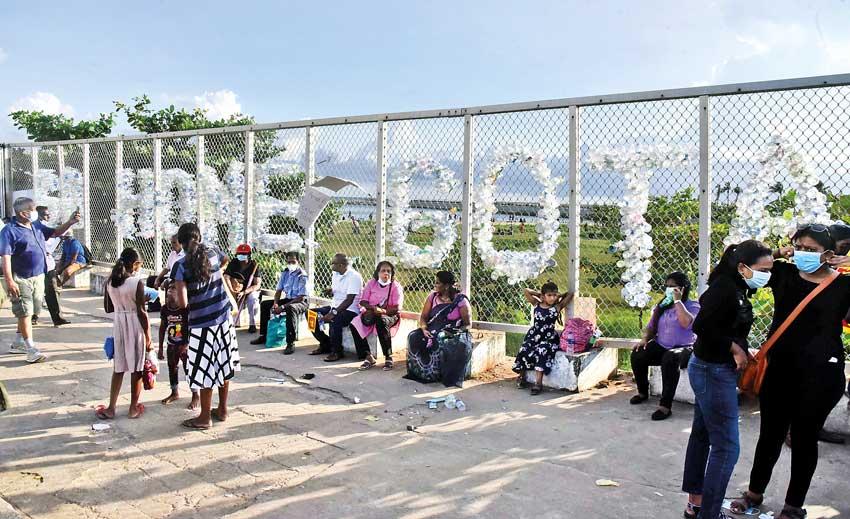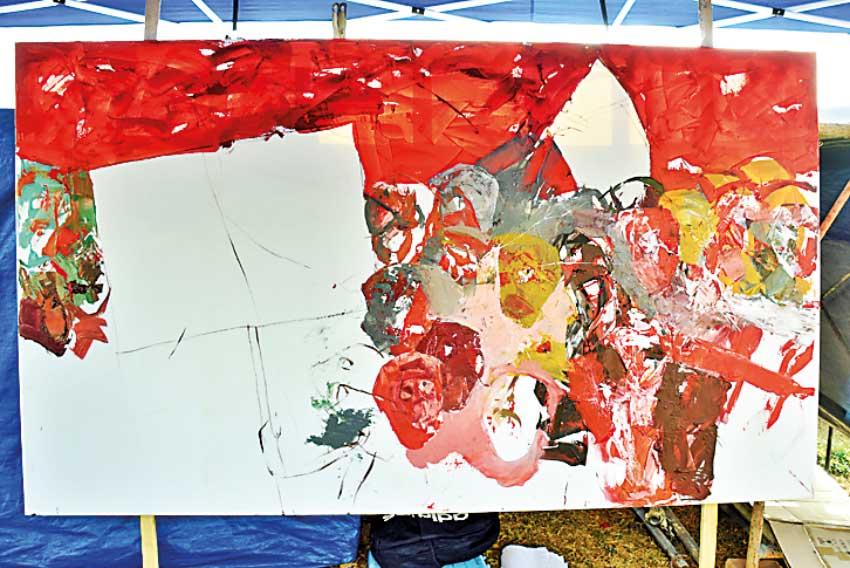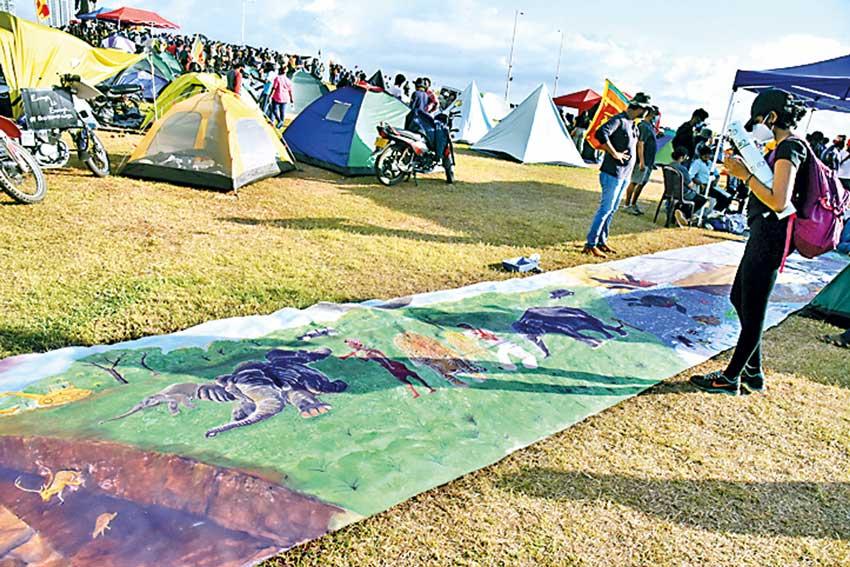Reply To:
Name - Reply Comment
Last Updated : 2024-05-19 23:42:00

Against plastic pollution
Pix by
Kithsiri De Mel and Kushan Pathiraja
 For centuries, the relationship between politics and arts has been a strong one and what transpired centuries ago in Europe for instance, is now becoming more evident in Sri Lanka. The protest site at Galle Face Green has now been transformed into a space that attracts creativity. From artists to musicians to theatre artistes to actors and everybody else with some sense of creativity has something to contribute to make this struggle more visually pleasing. On a previous occasion, two actors did a performance art in memory of the Easter Sunday attacks. Performance artistes from the Ogha Collective portray their creative concepts from time to time, giving a novel experience to protesters. Banners with creative slogans, artworks with alternative concepts could be witnessed throughout the protest site.
For centuries, the relationship between politics and arts has been a strong one and what transpired centuries ago in Europe for instance, is now becoming more evident in Sri Lanka. The protest site at Galle Face Green has now been transformed into a space that attracts creativity. From artists to musicians to theatre artistes to actors and everybody else with some sense of creativity has something to contribute to make this struggle more visually pleasing. On a previous occasion, two actors did a performance art in memory of the Easter Sunday attacks. Performance artistes from the Ogha Collective portray their creative concepts from time to time, giving a novel experience to protesters. Banners with creative slogans, artworks with alternative concepts could be witnessed throughout the protest site.
|
Against plastic pollution
Sujith Rathnayake |
“This struggle is part of a positive revolution”: Sujith Rathnayake
A week ago, a blank canvas was mounted inside a little hut at Galle Face Green. This is veteran artist Sujith Rathnayake’s little abode at the protest site. Today, several brush strokes in hues of reds and oranges have occupied the white space. But the artwork is yet to be completed. For Rathnayake, art is something that goes beyond the popular perception. Having witnessed various crises and struggles over the years and having produced various evoking artworks over these periods, Rathnayake says that this is a historic juncture as all people have united to voice against corruption and injustice.
Excerpts of the interview with the Daily Mirror:
Q How do art and artists contribute to a people’s struggle?
Sri Lankans don’t appreciate arts. But when someone does a painting in an environment like this, people are interested to look at it. Since it is in the backdrop of a struggle, it also brings out the artist’s identity as well. I’m not drawing slogans here but it’s my perspective about the crisis. What we try to do here is to express ideas about the prevailing economic and political crisis through poems, songs, etc.
Q In the West, there is a link between politics and art, including paintings. But isn’t there a disconnect when it comes to the Sri Lankan context?
In Sri Lanka, people’s issues have been portrayed in the form of illustrations. Painters use certain symbols such as barbed wires, chains etc., to portray the feelings of the oppressed. Therefore the artists are trying to narrate a story through the painting. But art is not about narrating a story. In Sri Lanka most political issues were expressed in the form of cartoons that appeared in newspapers. Therefore people’s appreciation towards art has been temporary. For example, The School of Athens by Rafael is not a painting that can be thrown away just like that. But in the backdrop of a struggle, you cannot pay attention to all details because the environment is ever-changing. Yet, the artist cannot betray his identity, ideology and perception. On the other hand we see various slogans here, from GoHomeGota to All 225 Must Go Home. But there’s no point in drawing a painting based on these slogans because people already know it. So we need to balance between our identities while portraying the issue at hand and also give some insight about the aesthetic to the spectators. I am also trying to ensure that people get to enjoy the texture of the brush strokes.

Rathnayake’s partially completed painting
Q How long would it take to complete your painting?
That is unpredictable. I have been drawing paintings during previous crises periods as well. But I always keep a tab on things that take place. Therefore we are uncertain about what would happen the next moment. As such, the artwork also keeps changing. If the struggle ends tomorrow, I might pack everything and take it home and complete it. But the final artwork will not be related to the struggle. We also need to look at the mood of the people. Their anger, dedication to camp here irrespective of rain or shine etc., and I have observed that everyone of them have a similarity when it comes to chanting slogans. All of them chant with the same spirit and energy irrespective of differences. We have observed this as artists, and I am trying to add a cultural and aesthetic element to this observation.
Q Do you see a difference in this struggle, compared to the previous ones and crises that you have witnessed?
There were struggles in leftist political movements and every one of them had their political angles. From free education to class differences, ethnic issues, imperialism etc., these were struggles based on principles. The problem in this crisis is that people have an issue with the fact that one family enjoyed all luxuries on their own. We see more people in the middle class segments participating in protests. But in recent history we have seen limited participation of this segment in struggles. One speciality is that they too are present here. The struggle began because people had to languish in queues to obtain fuel, gas and the high cost of living had affected people in the lower income segments. People didn’t scold rulers prior to this crisis. But what they started now, has expanded with cultural diversity, freedom of expression and unity. But on the other hand, we see unknown businessmen, YouTubers and people with vested interests also trying to promote themselves here.

Part of the 60-foot long ecocide mural
Q What is your perception about people’s art literacy?
The visual and performing arts university is the highest institution in terms of visual arts. So once students get selected and obtain a degree, they engage in a profession or draw paintings for a hotel etc. But they haven’t made any attempts to disseminate knowledge on aesthetic variants, art history and terms used to describe art to the social segments that they represent. In Europe, even a pauper knows the basics of visual arts, music etc. Nobody knows the number of paintings that emerged since pre-historic period. But there are important artists from Picasso to Rafael, Michelangelo and Wassily Kandinsky who introduced abstract art and people should have a basic knowledge about them. Even if people don’t do sports, arts, agriculture etc., they should have some basic knowledge about these avenues.
People have limited knowledge about the fundamentals, terminology, milestones and other details in visual arts. In most instances the artwork is different to the artist’s narration of his piece. Therefore the viewer has to make his own interpretation and it may not be accurate. It wouldn’t have happened if knowledge was disseminated from university students. Those engaged in any field of study should be able to teach them to a child. Most artists want to be superior to the public. It’s an advantage to them when people are less aware of the field. But this is different in Europe. Some artists even misinterpret their artworks. There are visual effects such as brush strokes, dots etc., in an artwork and if the viewer see these as a dinosaur or something else, the artist would endorse it as well.
Q Many people came out to support this struggle; what is your message to society?
This is a historic moment. People aren’t afraid of the Police, military or even the emergency law. In previous protests, women’s participation was limited. But here there are youth, middle-aged people, women and even children. Children cannot participate in protests as per certain conventions. Therefore are we going to reject all laws and then abide by them later on? The results of this struggle would be felt in years to come. Adults can bare insecurity. But not children. We don’t know how they feel about this situation. People live in fear and they don’t have time to think of children. We have come across the ’83 Black July riots, ‘88/89 insurrection, tabling of the 1978 Constitution, education reforms, birth of the Internet, mobile phones, construction of highways, tsunami, the ethnic conflict etc. This struggle is part of a positive revolution, because we never thought people would unite to voice against injustice and corruption in this manner.
Portraying ecocide with creativity
Since 2019, the environment has been at the receiving end of petty political agendas. From mass scale deforestation to poaching, hunting for ivory, snaring of leopards, bio theft and the X-Press Pearl disaster, much irreversible damage has been done to nature. Portraying all these events on a 60-foot long banner, a group of volunteers, students and people passionate about the environment drew a mural to be mounted at the protest site. The mural now stands tall against a hedge located adjacent to the Shangrila Hotel.

Add comment
Comments will be edited (grammar, spelling and slang) and authorized at the discretion of Daily Mirror online. The website also has the right not to publish selected comments.
Reply To:
Name - Reply Comment
The state-run loss-making State Mortgage & Investment Bank (SMIB) has reveale
US authorities are currently reviewing the manifest of every cargo aboard MV
On March 26, a couple arriving from Thailand was arrested with 88 live animal
According to villagers from Naula-Moragolla out of 105 families 80 can afford
17 May 2024 - 0 - 134